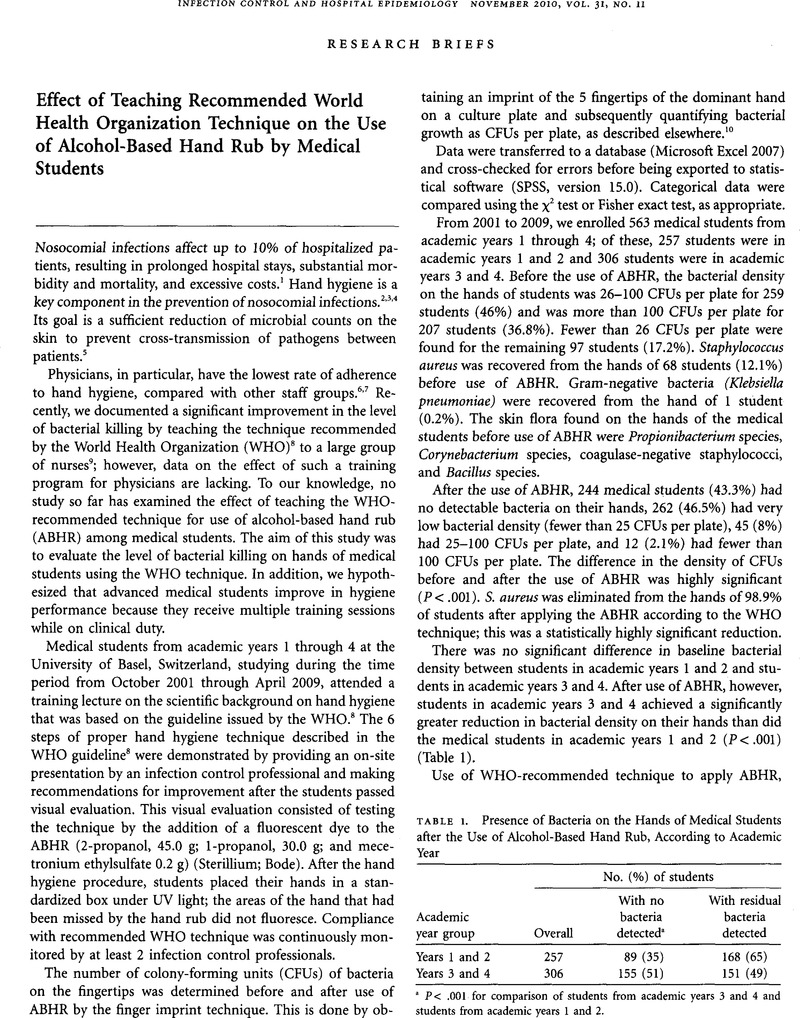Crossref Citations
This article has been cited by the following publications. This list is generated based on data provided by Crossref.
Tschudin-Sutter, S.
Frei, R.
Dangel, M.
Stranden, A.
and
Widmer, A. F.
2012.
Rate of Transmission of Extended-Spectrum Beta-Lactamase-Producing Enterobacteriaceae Without Contact Isolation.
Clinical Infectious Diseases,
Vol. 55,
Issue. 11,
p.
1505.
Widmer, A.F.
2013.
Surgical hand hygiene: scrub or rub?.
Journal of Hospital Infection,
Vol. 83,
Issue. ,
p.
S35.
Ellingson, Katherine
Haas, Janet P.
Aiello, Allison E.
Kusek, Linda
Maragakis, Lisa L.
Olmsted, Russell N.
Perencevich, Eli
Polgreen, Philip M.
Schweizer, Marin L.
Trexler, Polly
VanAmringe, Margaret
and
Yokoe, Deborah S.
2014.
Strategies to Prevent Healthcare-Associated Infections through Hand Hygiene.
Infection Control & Hospital Epidemiology,
Vol. 35,
Issue. S2,
p.
S155.
Galluzzi, Valerie
Herman, Ted
Shumaker, D. J.
Macinga, D. R.
Arbogast, J. W.
Segre, Elena M.
Segre, Alberto M.
and
Polgreen, Philip M.
2014.
Electronic Recognition of Hand Hygiene Technique and Duration.
Infection Control & Hospital Epidemiology,
Vol. 35,
Issue. 10,
p.
1298.
Ellingson, Katherine
Haas, Janet P.
Aiello, Allison E.
Kusek, Linda
Maragakis, Lisa L.
Olmsted, Russell N.
Perencevich, Eli
Polgreen, Philip M.
Schweizer, Marin L.
Trexler, Polly
VanAmringe, Margaret
and
Yokoe, Deborah S.
2014.
Strategies to Prevent Healthcare-Associated Infections through Hand Hygiene.
Infection Control & Hospital Epidemiology,
Vol. 35,
Issue. 8,
p.
937.
Ellingson, Katherine
Haas, Janet P.
Aiello, Allison E.
Kusek, Linda
Maragakis, Lisa L.
Olmsted, Russell N.
Perencevich, Eli
Polgreen, Philip M.
Schweizer, Marin L.
Trexler, Polly
VanAmringe, Margaret
and
Yokoe, Deborah S.
2014.
Strategies to Prevent Healthcare-Associated Infections through Hand Hygiene.
Infection Control & Hospital Epidemiology,
Vol. 35,
Issue. 8,
p.
937.
Widmer, Andreas F.
Lakatos, Botond
and
Frei, Reno
2015.
Strict Infection Control Leads to Low Incidence of Methicillin-ResistantStaphylococcus aureusBloodstream Infection over 20 Years.
Infection Control & Hospital Epidemiology,
Vol. 36,
Issue. 6,
p.
702.
Tschudin-Sutter, Sarah
Sepulcri, Daniel
Dangel, Marc
Schuhmacher, Heinz
and
Widmer, Andreas F.
2015.
Compliance with the World Health Organization Hand Hygiene Technique: A Prospective Observational Study.
Infection Control & Hospital Epidemiology,
Vol. 36,
Issue. 4,
p.
482.
Škodová, Manuela
Gimeno-Benítez, Alfredo
Martínez-Redondo, Elena
Morán-Cortés, Juan Francisco
Jiménez-Romano, Ramona
and
Gimeno-Ortiz, Alfredo
2015.
Hand hygiene technique quality evaluation in nursing and medicine students of two academic courses.
Revista Latino-Americana de Enfermagem,
Vol. 23,
Issue. 4,
p.
708.
Chou, Po‐Yen
Doyle, Aimie J.
Arai, Shiori
Burke, Pierre J.
and
Bailey, Trina R.
2016.
Antibacterial Efficacy of Several Surgical Hand Preparation Products Used by Veterinary Students.
Veterinary Surgery,
Vol. 45,
Issue. 4,
p.
515.
Reilly, Jacqui S.
Price, Lesley
Lang, Sue
Robertson, Chris
Cheater, Francine
Skinner, Kirsty
and
Chow, Angela
2016.
A Pragmatic Randomized Controlled Trial of 6-Step vs 3-Step Hand Hygiene Technique in Acute Hospital Care in the United Kingdom.
Infection Control & Hospital Epidemiology,
Vol. 37,
Issue. 6,
p.
661.
Chraïti, Marie‐Noëlle
and
Widmer, Andreas F.
2017.
Hand Hygiene.
p.
70.
Tschudin-Sutter, S.
Rotter, M.L.
Frei, R.
Nogarth, D.
Häusermann, P.
Stranden, A.
Pittet, D.
and
Widmer, A.F.
2017.
Simplifying the WHO ‘how to hand rub’ technique: three steps are as effective as six—results from an experimental randomized crossover trial.
Clinical Microbiology and Infection,
Vol. 23,
Issue. 6,
p.
409.e1.
Price, Lesley
Melone, Lynn
McLarnon, Nichola
Bunyan, Donald
Kilpatrick, Claire
Flowers, Paul
and
Reilly, Jacqueline
2018.
A systematic review to evaluate the evidence base for the World Health Organization's adopted hand hygiene technique for reducing the microbial load on the hands of healthcare workers.
American Journal of Infection Control,
Vol. 46,
Issue. 7,
p.
814.
Lulla, Martins
Rutkovskis, Aleksejs
Slavinska, Andreta
Vilde, Aija
Gromova, Anastasija
Ivanovs, Maksims
Skadins, Ansis
Kadikis, Roberts
and
Elsts, Atis
2021.
Hand-Washing Video Dataset Annotated According to the World Health Organization’s Hand-Washing Guidelines.
Data,
Vol. 6,
Issue. 4,
p.
38.
Durso, Francis T.
Parmar, Sweta
Heidish, Ryan S.
Tordoya Henckell, Skyler
Oncul, Omer S.
and
Jacob, Jesse T.
2021.
Improving the communication of hand hygiene procedures: Controlled observation, redesign, and randomized group comparisons.
Infection Control & Hospital Epidemiology,
Vol. 42,
Issue. 2,
p.
194.
Abuga, Kennedy
and
Nyamweya, Nasser
2021.
Alcohol-Based Hand Sanitizers in COVID-19 Prevention: A Multidimensional Perspective.
Pharmacy,
Vol. 9,
Issue. 1,
p.
64.
Lacey, Gerard
Gozdzielewska, Lucyna
McAloney-Kocaman, Kareena
Ruttle, Jonathan
Cronin, Sean
and
Price, Lesley
2022.
Psychomotor learning theory informing the design and evaluation of an interactive augmented reality hand hygiene training app for healthcare workers.
Education and Information Technologies,
Vol. 27,
Issue. 3,
p.
3813.
Quan, Ho Dac
Khai, Huynh Duc
and
Huynh, Hieu Trung
2022.
Ordinary differential equation based neural network coupled with random forest in the quality assessment of hand hygiene processes.
Applied Soft Computing,
Vol. 130,
Issue. ,
p.
109627.
Price, Lesley
Gozdzielewska, Lucyna
Matuluko, Ayodeji
Pittet, Didier
Allegranzi, Benedetta
and
Reilly, Jacqui
2022.
Comparing the effectiveness of hand hygiene techniques in reducing the microbial load and covering hand surfaces in healthcare workers: Updated systematic review.
American Journal of Infection Control,
Vol. 50,
Issue. 10,
p.
1079.



